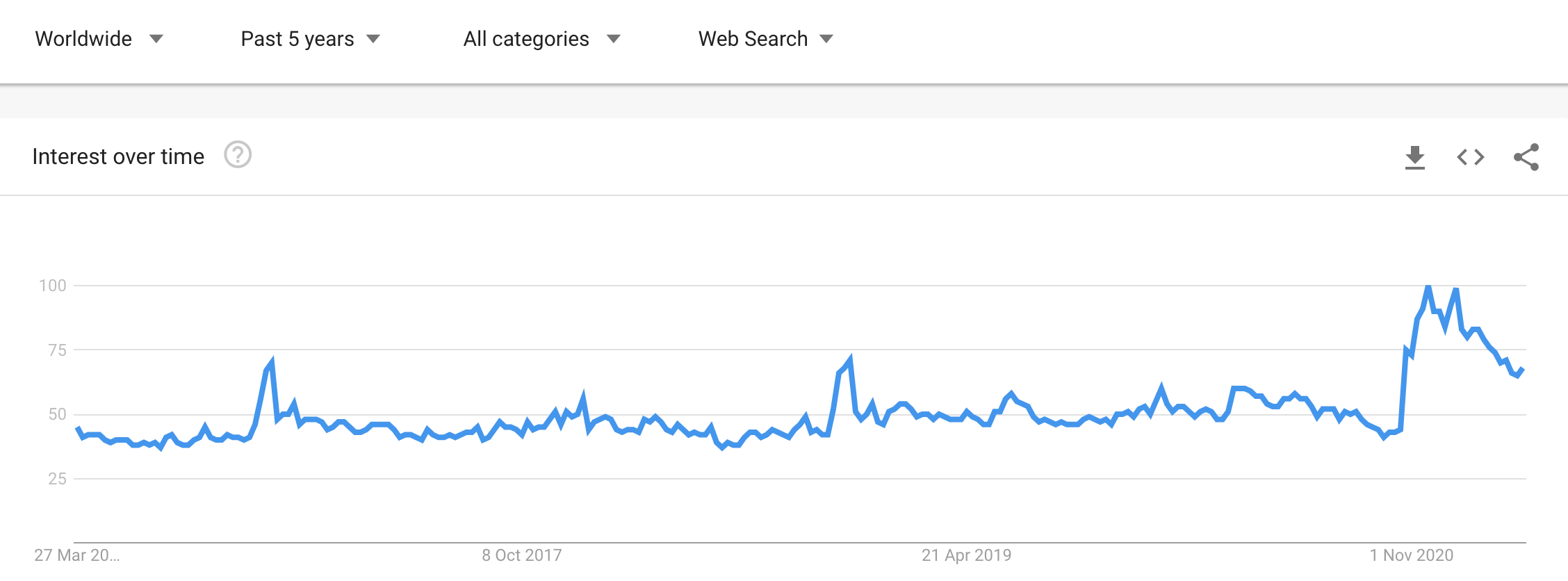Over the past several months there has been an impressive rise in interest in chess. Worldwide Google searches for chess hit their highest point for the last five years, and sales for chessboards skyrocketed. What’s behind this resurgence in popularity? The Netflix-hit Queen’s Gambit, featuring a young, female chess prodigy on her journey to become the greatest chess player in the world, is almost certainly responsible, making chess exciting to a new generation – at least for now!

Image 1. Google search trends for ‘Chess’ worldwide over the last five years

Image 2. A screenshot from the Netflix show “The Queen’s Gambit”.
At a basic level, these online search trends confirm that media has the ability to influence people’s behaviour. Indeed, the leveraging of media to influence people has a long history, including the reassuring radio broadcasts of Franklin D. Roosevelt’s “fireside chats” in the 1930s, to 10-second TikTok videos today. Both of these examples owe their success, in part, to video and audio content’s most appealing feature when it comes to promoting behaviour change – reach.
Video streaming is projected to make up 82% of all internet traffic by 2022 and around 75% of households in developing countries have access to a radio. With this orbit, the potential for media to inform or persuade people and change their behaviour is unparalleled.
While the surge in chessboard sales was incidental and perhaps superficial, there is a growing amount of evidence on the positive impact video and audio content can have on critically important issues too. Mass media interventions have been successful at shifting a variety of behaviours, from encouraging HIV testing in Nigeria through an MTV show Shuga, to reducing inter-ethnic prejudice in Rwanda through radio shows, to increasing reporting of domestic violence using short films at film festivals in Uganda.
These types of behaviour changes can occur closer to home too. Indeed, while not yet rigorously evaluated, the boon in HIV testing in the UK in 2021 can largely be attributed to the launch of Channel 4’s pop culture phenomenon, It’s A Sin, which provides an in-depth, heart-wrenching, televised depiction of the beginning of the HIV/AIDS crisis in 1980s Britain.

Image 3. A screenshot from the short films in Uganda showing community awareness of violence against women and regret at not taking action.
While these examples show the promise of mass media as a tool to tackle large societal issues, understanding how mass media works to change behaviour is crucial to bringing its full potential to bear.
An area that, as behavioural scientists, we are most keen to understand, is the psychological mechanisms by which mass media successfully changes attitudes and behaviours. For example, “Edutainment”, a specific subset of mass media, seeks to educate the audience whilst entertaining. It is underpinned by the notion that conveying information while entertaining viewers reduces resistance to top-down advice and makes the audience more likely to pay attention to a particular message.
Exactly what constitutes edutainment is not well-defined but could encompass any content with educational themes alongside entertainment – even the hit show RuPaul’s Drag Race, which showcases the Drag Queens’ lives and experiences alongside their competition to become the Drag Race Superstar. Similarly, the ability for media – and video content in particular – to create strong emotional responses may be critical to changing certain types of behaviour like discrimination, which can be deeply rooted in emotions. These theories beg the question of how entertaining or emotional does the content need to be? And, importantly, what messages might trigger costly unintended consequences, such as further entrenching the stigmatization of a certain group?
At BIT we are already working hard to answer these questions. We are currently running interventions using video and audio content to change behaviour around social cohesion in Nigeria as part of our Smart Peace work. At the same time, we are using similar content levers to reduce stigmatisation of Coronavirus in Bangladesh, combat violence against women and girls in Peru and South Africa, and enhance anti-corruption edutainment programming in Nigeria.
In addition to testing media interventions in different contexts, we are also working to understand which techniques from behavioural science are most effective. For example, we recently concluded a project researching the most impactful framing for narratives in order to shift mindsets and behaviours around health and financial issues.
Narrative can be a powerful tool for behaviour change, as it provides a psychological safety net – creating distance between the viewer and the character – which allows the audience to confront new and different ideas, norms, and behaviours in a forum that is non-threatening. This makes it an effective format for conveying controversial views.
Our early work has shown that there are many more concepts from behavioural science that are ripe for incorporation in mass media interventions. The “messenger effect,” – or idea that we are heavily influenced by who communicates information – may, for example, have implications for which character delivers critical information or invites reflection. Another concept that can be leveraged through the medium of video includes the “mere-exposure effect” which says the more familiar we are with something, the more we like it. Repeated exposure to say, HIV testing or even the concept of a more equal world, can therefore increase our familiarity and overall preference for it – possibly leading to an increased demand for the idea over time.
With their reach and ability to hold an audience captive, media interventions have the potential to be exceptional engines for change and address some of the most prominent social issues we face. If we are able to build the evidence base through well-designed content and evaluations then we may be able to put Netflix, TikTok and billions of TVs, radios and smartphones around the world to greater use for the benefit of all.





